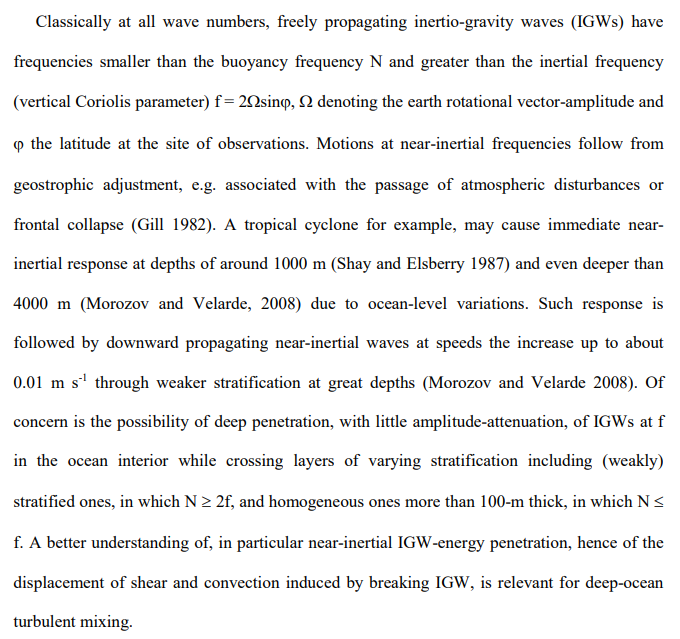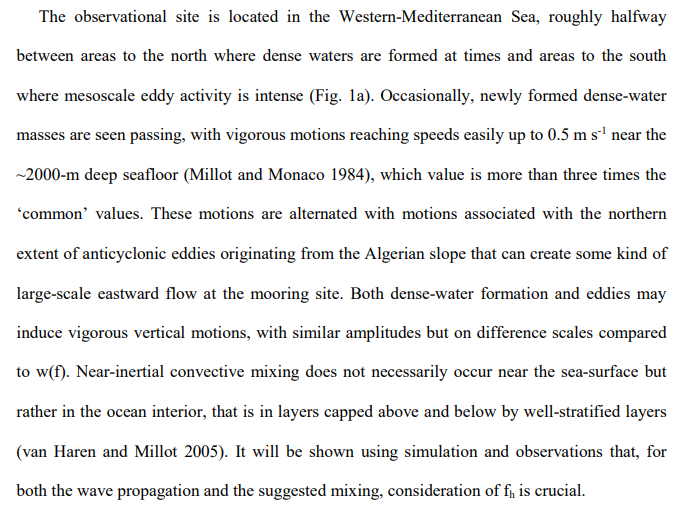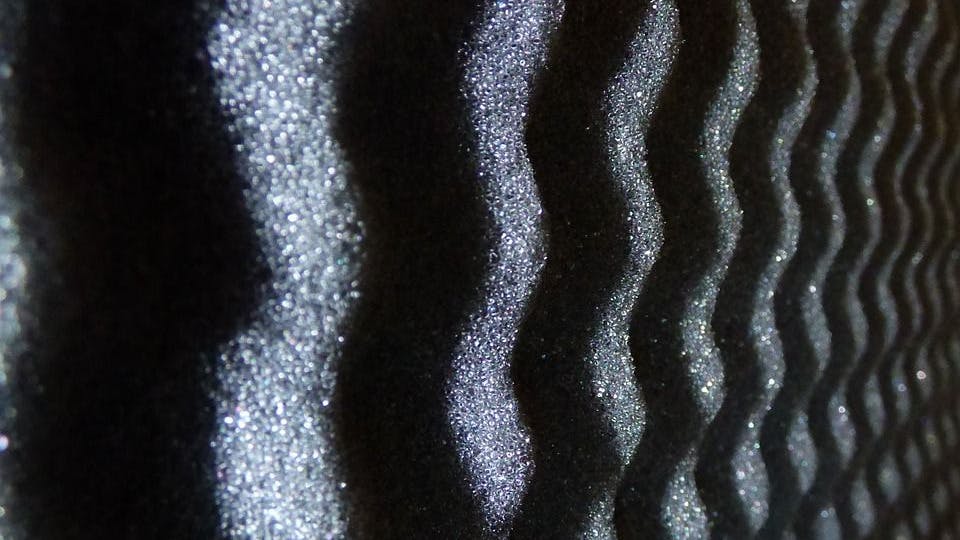Authors:
(1) Hans van Haren, NIOZ Royal Netherlands Institute for Sea Research, P.O. Box 59, 1790 AB Den Burg, the Netherlands.
Table of Links
Abstract
The propagation of inertio-gravity waves (IGW) into the deep-sea is relevant for energy transfer to turbulence where waves break, and thus for redistribution of nutrients, oxygen and suspended matter. In constant stratification, vertical IGW-propagation is readily modelled. In varying stratification, where homogeneous layers alternate with stratified layers, transmission and reflection cause complex patterns. Half-year long moored acoustic Doppler current profiler (ADCP) observations midway between the Balearic Islands and Sardinia in the 2800- m deep Western-Mediterranean Sea occasionally demonstrate a distinct transition, between weakly stratified (N2f) and homogeneous (Nf) layers, of IGW at near-inertial frequencies. Here, N denotes the buoyancy frequency and f the local inertial frequency (vertical Coriolis parameter). The transition in stratification is rather abrupt, within z=25 m and provides an amplitude-reduction of 1.3 for super-inertial motions. Simulations with non-traditional momentum equations involving the horizontal Coriolis parameter fh qualitatively confirm observed IGW-refraction. The observational area is marked by variations in hydrographic characteristics, with abundant mesoscale eddies to the south and dense-water formation to the north of the site during the previous winter. Thus, also transitions occur from deep homogeneous layers into deeper, recently formed stratified ones. Polarization spectra of shear are bound by IGW-limits related to N=f, while current-polarization to 2fh. These frequencies coincide with large-scale buoyancy frequencies independently observed in various layers using shipborne CTD-profiling.
Keywords Vertical near-inertial wave propagation; transition between homogeneous and weakly stratified layers; deep Western-Mediterranean; ADCP-observations; non-traditional momentum equations
1 Introduction


For the latter area, two observational studies in the southern Algerian sub-basin (van Haren and Millot 2004; 2005) suggested near-inertial IGW-propagation, following un-attenuated passage, across the interface between stratified and homogeneous layers. Near-inertial IGWmotions in homogeneous layers generally have marked rectilinear polarization in the horizontal plane [u, v] and show a large aspect ratio of elevated vertical (over horizontal) velocities w(f)/[u, v](f) = 0.1-1. In stratified layers of the ocean, near-inertial horizontal polarization is much more circular and aspect ratios are only O(0.01-0.001).
In convective chimneys of a dense-water formation area, vertical currents are easily distinguished from those at near-inertial frequencies (Voorhis and Webb 1970; Gascard 1973; Schott and Leaman 1991). The former vary more rapidly, O(1 hour) or less, in both frequency and amplitude, and they are much more irregular when registered at a mooring, compared to motions at a particular frequency like f. Although vertical currents associated with deep-water formation have been extensively studied (see review by Marshall and Schott (1999), the importance of relatively large w(f) is not explored yet to its full extent.
In this paper, the focus is on w(f) related to near-inertial IGW-propagation, and on homogeneous layers that are much thicker than the typical buoyancy scale O(10-100) m (Fig. 1b). Specifically, the w(f)-transition is studied between stratified and homogeneous layers using observations and a simulation. Also, the relationship is considered between observed spectral IGW characteristics and stratification.

This paper is available on arxiv under CC 4.0 license.
